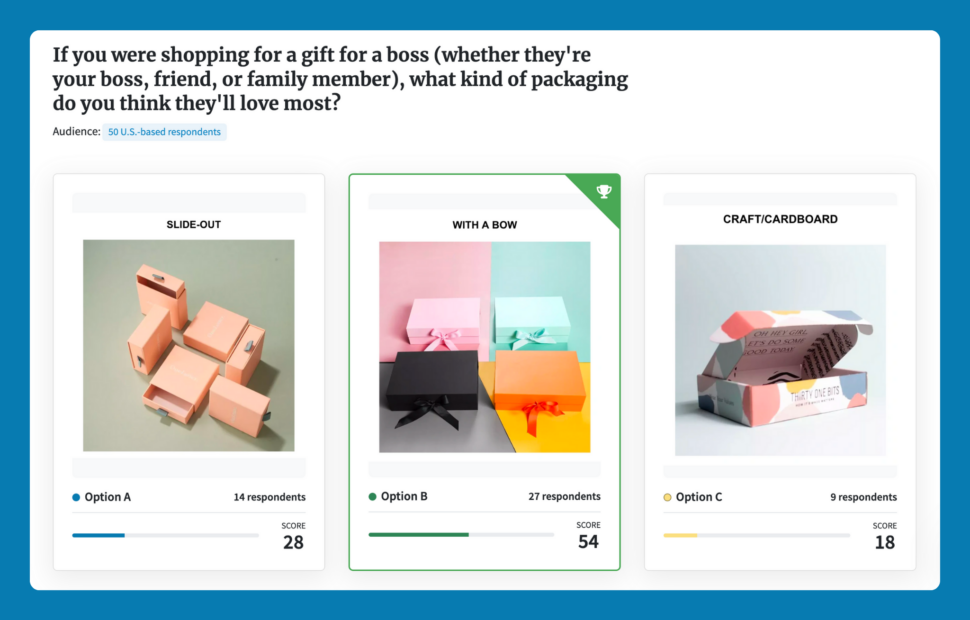Table of contents
- Table of contents
- 1. Learn the Amazon magic formula
- 2. Gather product ideas
- 3. Use PickFu to tap your target market
- Is it hard to be successful selling on Amazon?
- FAQs
In this post you’ll learn how to apply the Amazon magic formula—low competition + high demand + 15–25% profit margins—to identify winning products, explore market-ready ideas via Amazon Best Sellers and Chrome extensions, and validate your concepts with PickFu polls for unbiased, real-shopper feedback in minutes.
If you want to figure out how to find the best products to sell on Amazon, you’re not alone. Every day, people dream of starting an Amazon FBA empire so profitable that they can kiss their boring nine-to-five job goodbye.
But let’s pump the brakes for a minute. Finding the right products to sell online takes careful research. The last thing you want is to throw all your time, energy, and money into a cool idea only to discover that it doesn’t sell.
We’re here to help you understand how to find the best-selling products on Amazon. All it takes is a magic formula and some elbow grease.
1. Learn the Amazon magic formula
The Amazon Marketplace is more crowded than Times Square on New Year’s Eve. And because of that, your products have to stand out big-time in the e-commerce world.
So before you even start researching products to sell, learn this magic formula. Memorize it. Write it on a sticky note and slap it on your desk. Whatever you need to do to remember it, do that.
Here it is:
Low competition + high demand + profit margins of 15 to 25% = Amazon selling success
Let’s break down these three crucial parts of an Amazon success story.
Low competition means there aren’t many other sellers selling a specific product or category of products.
High demand indicates that your target audience (more on that in a moment) craves a product. They buy it, they love it, and they come back for more. There’s always a high search volume.
A profit margin is the amount of money you, the Amazon seller, get to take home after you deduct expenses. A common formula to calculate profit margins is:
(Net income/revenue) x 100 = Net profit margin
So let’s say you decide to sell yoga mats. They cost $23 each for you to purchase from the manufacturer and store with Amazon’s Fulfillment-by-Amazon (FBA) program. You sell each mat for $30, leaving you with a net profit of $7 per mat.
Your formula would look like this: (7/30) x 100 = 23.3%
Not bad! To build a sustainable e-commerce business, you’ll need to keep those margins between 15 and 25%, or higher.
Be prepared to calculate an estimated profit margin for each product you consider selling.
2. Gather product ideas
The easiest way to discover high-demand, low-competition Amazon products to sell is to do some product research on the giant itself.
To start out, explore different categories on Amazon. Clothing, shoes, jewelry, books, personal care… there’s a category for just about anything.
Go to the Amazon Best Sellers page, click on a category that interests you, and start exploring those trending best-sellers.
To find products, narrow down a category or two that you find intriguing. Choose one that has a wide range of products, including a few that you think might be low-competition and high-demand.
Now, figure out if they actually are.
This is where Chrome extensions save you a ton of work. We like AMZScout’s Amazon Product Finder. As you browse Amazon and look at different product categories, the extension will show you super helpful data points for each, including:
- Number of people selling the product
- Selling price
- Amazon FBA fees
- Net margin
- Estimated sales
- Estimated revenue
- Time the product has been on the market
- Overall likelihood that the niche will be profitable
When we looked up yoga mats, we found that this product subcategory has low competition and decent demand. AMZScout provides direct links to help you find suppliers on Alibaba, discover the keywords the product ranks for, and see how much profit you could make off the product.
Let’s say you decide to sell eco-friendly cork yoga mats on the Amazon Marketplace. You find a few options on Alibaba. You like the look of a listing that offers customizable packaging, logo design, and graphics.
AKA, you can put any peaceful, yoga-esque image you want on these cork mats.
You could then use AMZScout’s profit calculator tool to see how much you’d make from these yoga mats after taking costs like shipping and taxes into account.
We recommend you take your time exploring Amazon with the AMZScout, Helium 10, or Jungle Scout Chrome extension. If there’s something you don’t understand about the data, use tutorials and videos to help you figure out what you’re looking at.
Here are three points to keep in mind:
- Products should be popular and trending all year long, not just during the holiday season
- Larger products mean higher storage and shipping costs. Consider sticking to small, light, easily stored items that arrive fast at your customer’s door.
- Stay away from technology. You’ll be competing with giants like Apple and Samsung, and if something goes wrong with your tech product, you can expect bad reviews.
Once you narrow down a potentially profitable product (or three), it’s time to get to know your target audience.
Don’t customize and purchase a bunch of products — yet! That’s a beginner’s mistake. Instead, order a sample of the product with your custom design and branding, if possible, and take some high-quality product photos.
When it comes to sourcing products, you can try dropshipping, order products from eBay, or find private-label items that you can white-label.
3. Use PickFu to tap your target market
Your target market, or audience, is the group of people that will buy your product. It’s usually easy enough to figure out a general target audience.
Who’s the target audience for snazzy pet collars? Pet owners.
What about epic role-playing video games? Video gamers, of course.
And yoga mats? People who do yoga.
Easy, right? These are the types of products that will always be in demand.
But actually talking to your target audience is trickier. Yet nothing is more valuable than picking your target audience’s mind to gain unbiased feedback on your product or product category.
That’s where PickFu comes in.
PickFu gives you two key ingredients to be a top seller on Amazon:
- A huge pool of more than 15 million global consumers you can separate into over 90 different audience targeting traits with different metrics
- A variety of ways to ask these respondents questions, from head-to-head split test polls to open-ended Q&A polls and more
Best of all? It won’t break your bank. Polls start at $50 for 50 unbiased, written responses to your poll.
So let’s say you want to find out if people who do yoga would actually want to buy your cool, cork yoga mat. How in demand is a cork mat, anyway? Can it possibly become a top-selling item?
You upload an image of the mat to PickFu, choose a respondent pool of people who do yoga and shop on Amazon, and ask the big question: “Would you buy this product? Please explain.”
Your audience of Amazon-shopping yogis will tell you everything they love — and don’t — about your product.
You could also validate your new product by uploading your yoga mat and screenshots of competitors’ yoga mats. Ask your audience which one they would pick and why, like this respondent did. There’s nothing like comparing your product to similar products to see which one wins your customer’s loyalty.
You’ll receive detailed feedback, a vote, and demographic information to help you understand your target audience even better.
If the respondents don’t pick your yoga mat as their favorite, for example, you can read the responses to find out why. It’s like having customer reviews before the product ever hits the market. And you can choose the number of reviews yourself!
Use that feedback to make changes to your product design. Or, if the respondents don’t seem interested at all, find a different product to sell.
And thank your lucky stars you PickFu’d it before you bought 100 yoga mats from an Alibaba supplier.
PickFu can also help you with your next steps. Finding the right product is only the beginning of your Amazon seller journey. You’ll still need to:
- Make sure the packaging is amazing
- Line up your Amazon FBA or third-party fulfillment plan
- Take product photos
- Pick the perfect product title
- Create product descriptions and bullet points
- Weave relevant keywords into the copy
- Watch your sales rank rise
- Celebrate once you snag a best sellers rank (BSR)
With PickFu, you can test your packaging, product images, product title, and product description. We help you make sure every single thing in your listing looks fabulous to your target audience.
In other words, we’re your go-to for product listing optimization.
And when you’re ready to deploy your marketing strategy, we’re here to help you create the perfect ads for your soon-to-be top-selling products, too.
Our respondents can truly do it all.
Is it hard to be successful selling on Amazon?
No! Amazon can be profitable if you make smart decisions about which products to sell and keep your finger on the pulse of your target audience. That old adage — work smarter, not harder — applies here. The key is finding trending products you can sell with little competition.
With the Amazon BSR magic formula in mind, take time to do product research, find popular products that are profitable for you, and see if your target audience would actually buy them. Don’t forget to optimize everything for SEO, too.
You’ll be on your way to notching a spot in the Amazon best sellers rank in no time.
If you’re ready to start standing in the shoes of your target market, sign up for PickFu today.
FAQs
Navigate to Amazon’s Best Sellers page and check out the categories you’re interested in to see which products are selling the most. You can also use a Chrome extension like AMZScout’s Amazon Product Finder to see which items are flying off the shelves in each category you browse.
All you have to do is navigate to a page, click on the Amazon Product Finder under the Extensions button in your Chrome browser, and watch as data appears in front of you like magic.
Once your sales volumes go up, you can check on your seller central portal to see which products are your best-selling items.
The Amazon Best Sellers page offers many of the top-rated items on Amazon, as best-sellers tend to also have high ratings. You can also use a Chrome extension to browse multiple product listings at once. We like AMZScout’s Amazon Product Finder, which shows you the overall product rating for all the products under any search term you enter. It’s a lot easier than combing through product pages one by one.
Whatever you do, don’t pick a niche that’s already saturated with products. Earning a spot on the best sellers rank (BSR) is tough enough without oodles of competition. Follow the Amazon magic formula of low competition + high demand + profit margins of 15 to 25% = Amazon selling success. Use a Chrome extension to locate products with low competition and high demand. Get inside your target audience’s head with PickFu. Calculate your estimated profit margins for every product you add to your lineup. By taking these steps, you can ensure a higher chance of getting on the Amazon best sellers list. Make sure you keep tabs on your actual sales data once you start selling and make adjustments as needed.







